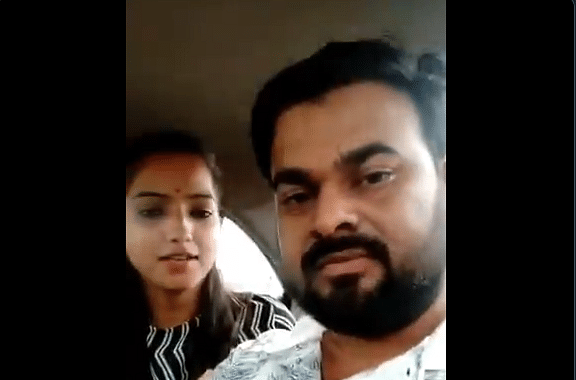The ordeal of BJP MLA’s daughter Sakshi Mishra and her husband Ajitesh Kumar could be straight out of an Indian soap opera. Parents objecting to their children’s marriages, love lives and threatening to act against them are as commonplace as the arranged marriage in Hindi TV serials.
Husbands being assaulted, as Ajitesh was outside the Allahabad court Tuesday, is as routine a mamla as husbands/men weeping in these TV dramas. Witness Colors TV’s Gathbandhan, where Raghu cries over an unconscious Dhanak, his teardrop falling on her eye and awakening her.
However, the main and very serious difference between the two is that what is happening to Sakshi and husband Ajitesh is very real and very frightening, where the threats easily translate into life and death moments.
Television news has done more than its fair share to ensure that no harm comes to the couple after she posted a video asking for legal protection because she feared reprisal from her father – Uttar Pradesh MLA Rajesh Mishra— after she married a Dalit man.
Sakshi’s video received widespread coverage; she was also interviewed by Hindi and English news channels like Aaj Tak and NDTV. Aaj Tak anchor Anjana Om Kashyap roundly scolded Rajesh Mishra on her show with Sakshi– what’s interesting is that so deep-rooted is the prejudice that in spite of being questioned and almost humiliated on national television, Mishra did not relent, refused to converse with Sakshi or change his mind about the marriage.
Will the law and the media, together, be able to keep a watchful eye on the couple to ensure their safety? Keep watching.
Another difference between Sakshi’s case and TV dramas is that in the latter it is the mother of the bridegroom, not the father of the bride, who objects to the union or affair.
Also read: Dalits want job reservation but equality in marriage — trolls tell ‘honour killing’ widow
For instance, wily Nimki may have inveigled herself into her husband’s affections and into his home, but his mother is brokenhearted and enraged by her and is doing everything she possibly can to get rid of her (Nimki Mukhiya, Star Bharat).
Nimki has returned to Babbu, despite being raped by him, forsaken her family and the man she loved to live with her husband and his family while bearing Babbu’s child. The parents detest her because they believe she is beneath their touch, but Nimki has been more than a match for them thus far.
That a protagonist who has symbolised women’s empowerment on television could have so easily forgiven and accepted her rapist husband, even if she is plotting some deep and dark revenge, says something about the patriarchal framework of Indian TV serials.
Raghu’s mother Savitri bai detests her police officer daughter-in-law Dhanak and is likewise intent on removing her from her son’s affections—it’s another matter that she accidentally gets her kidnapped (Gathbandhan, Colors TV).
Dhanak is a role model for young women. You ought to have seen her knee her kidnapper where it hurts a man the most and the land him a few punches that Mary Kom would have applauded. If there is indeed to be a female 007 (not James Bond) as reports suggest, Dhanak would be a good choice.
Gathbandhan is also unusual in that Savitri bai is a mafia don who swills whiskey and curses with equal felicity—and doesn’t care who knows it.
And then there is Prerna’s plight in Kasauti Zindagi Ki 2.0 (Star Plus). Her mother-in-law does everything to prevent her beloved son ‘Onu’ (Anurag) from entangling himself in Prerna’s long tresses and if she doesn’t succeed it isn’t for want of trying. Why, she even gets Onu married to the wicked Komolika in order to keep Prerna out of her home and hearth, but she cannot keep her out of Anurag’s heart.
That is something Mr Bajaj is hoping to do. He has blackmailed Prerna into marrying him – her self-sacrifice to save Anurag from financial disaster. The long-suffering ‘love that cannot speak its name’ between Prerna and Anurag will continue endlessly, while Mr Bajaj tries to win her over.
By the way, you’ve never seen anyone quite like him: he is invariably dressed in a three-piece suit, smoking a cigar, with eyes wide open and an unblinking stare. Most unnerving.
In each of these cases, the female lead character is considered an unsuitable woman for the man by his family. Interestingly, unlike real life, no ostensible reason is actually furnished for the mismatch — there is no mention of caste or class differences and it is never based on religion because serials keep the religions segregated – serials about Hindu families don’t feature Muslims and vice versa.
Also read: Unemployment is rampant in Indian TV serials, but not in the way you think
In Hindi serials, the differences are implicit; often, money and the status it imparts to the family is the key: Nimki is the daughter of a taxi driver, Babbu is the local politician’s son. Anurag’s family is fabulously wealthy, Prerna’s father works in his family firm; and as for Raghu and Dhanak, well, they are just worlds apart.
Back in the real world, the collapse of a building in Mumbai, Tuesday, saw news channels suspend all other programming or coverage for the entire day—most of the evening discussions were also about the sorry state of affairs in Mumbai.
Meanwhile, floods in Assam and Bihar, to mention two badly affected states, have destroyed homes and livelihoods to say nothing about the loss of life. However, television news only fleetingly reported on the calamities.
Why is it that a single building in a metro can command a full day’s coverage while an entire state or two can be ignored?







Zamaana mohabbat ka dushman purana …